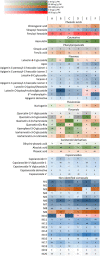Modulated Light Dependence of Growth, Flowering, and the Accumulation of Secondary Metabolites in Chilli
- PMID: 35392509
- PMCID: PMC8981241
- DOI: 10.3389/fpls.2022.801656
Modulated Light Dependence of Growth, Flowering, and the Accumulation of Secondary Metabolites in Chilli
Abstract
Chili is widely used as a food additive and a flavouring and colouring agent and also has great importance in health preservation and therapy due to the abundant presence of many bioactive compounds, such as polyphenols, flavonoids, carotenoids, and capsaicinoids. Most of these secondary metabolites are strong antioxidants. In the present study, the effect of light intensity and spectral composition was studied on the growth, flowering, and yield of chilli together with the accumulation of secondary metabolites in the fruit. Two light intensities (300 and 500 μmol m-2 s-1) were applied in different spectral compositions. A broad white LED spectrum with and without FR application and with blue LED supplement was compared to blue and red LED lightings in different (80/20 and 95/5%) blue/red ratios. High light intensity increased the harvest index (fruit yield vs. biomass production) and reduced the flowering time of the plants. The amount of secondary metabolites in the fruit varied both by light intensity and spectral compositions; phenolic content and the radical scavenging activity were stimulated, whereas capsaicin accumulation was suppressed by blue light. The red colour of the fruit (provided by carotenoids) was inversely correlated with the absolute amount of blue, green, and far-red light. Based on the results, a schematic model was created, representing light-dependent metabolic changes in chilli. The results indicated that the accumulation of secondary metabolites could be modified by the adjustment of light intensity and spectral composition; however, different types of metabolites required different light environments.
Keywords: LED lighting; capsaicine; chilli; flavonoids; secondary metabolites.
Copyright © 2022 Darko, Hamow, Marček, Dernovics, Ahres and Galiba.
Conflict of interest statement
The authors declare that the research was conducted in the absence of any commercial or financial relationships that could be construed as a potential conflict of interest.
Figures





References
-
- Al Murad M., Razi K., Jeong B. R., Samy P. M. A., Muneer S. (2021). Light emitting diodes (Leds) as agricultural lighting: impact and its potential on improving physiology, flowering, and secondary metabolites of crops. Sustainability 13 1–25. 10.3390/su13041985 - DOI
-
- Claypool N. B., Lieth J. H. (2020). Physiological responses of pepper seedlings to various ratios of blue, green, and red light using LED lamps. Sci. Hortic. 268:109371. 10.1016/j.scienta.2020.109371 - DOI
LinkOut - more resources
Full Text Sources

